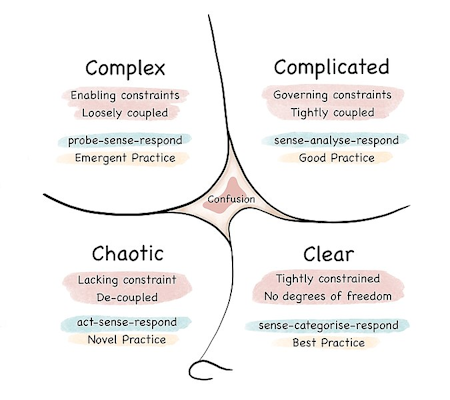Cynefin Framework
Provides dynamic sensemaking domains for decision-making under uncertainty.

The Cynefin (pronounced kuh-NEV-in) Framework, developed by Dave Snowden1, is a tool for situational leadership that helps Agile teams identify the nature of the challenges they face as Clear (formerly, Simple), Complicated, Complex, Chaotic, or Confusion (formerly, Disordered) and choose appropriate actions.2 By doing so, it prevents teams from misapplying processes, which is a common cause of inefficiency.
How Cynefin Impacts the Team:
Agile methods thrive in Complex environments where outcomes emerge through iteration, experimentation, and feedback. Misunderstanding the nature of the work can lead teams to use the wrong approach, resulting in inefficiency, frustration, or failure.
Cynefin helps Agile teams:
- Choose appropriate planning and delivery techniques.
- Recognize when to experiment vs. execute.
- Communicate risks and uncertainties more effectively.
- Adapt leadership and team behavior to the situation.
Scenario
Developing a New Mobile Banking App:
An Agile team is tasked with building a mobile app that allows users to view balances, transfer funds, and manage their accounts. Different parts of the project fall into different Cynefin domains.
Clear Domain
- Challenge: Creating standard UI components (e.g., login screen).
- Cynefin Guidance: Apply best practices and standard processes.
- Impact on the Team:
- The team uses pre-built design libraries and coding standards for efficiency.
- Routine tasks are added to a Kanban board and executed with minimal discussion.
Complicated Domain
- Challenge: Integrating with multiple banking APIs that have extensive documentation but require expertise.
- Cynefin Guidance: Analyze, consult experts, and follow good practices.
- Impact on the Team:
- The team assigns specialists to research and implement API integrations.
- Agile ceremonies like Sprint Planning & Backlog Refinement include detailed discussions on potential challenges and solutions.
Complex Domain
- Challenge: Designing a feature to improve customer engagement, such as personalized spending insights.
- Cynefin Guidance: Experiment and iterate to discover solutions.
- Impact on the Team:
- The team builds a Minimum Viable Product (MVP) to test user interest in the feature.
- Feedback from user testing drives iterative improvements during Sprints.
- Retrospectives focus on what worked and what didn't, adapting the approach as needed.
Chaotic Domain
- Challenge: A critical security vulnerability is discovered during the app's beta phase.
- Cynefin Guidance: Act immediately to stabilize, then assess and respond.
- Impact on the Team:
- The team shifts to a crisis management mode, suspending regular Sprint work.
- They patch the vulnerability immediately and implement long-term security measures afterward.
- A post-incident review is conducted to prevent similar issues in the future.
Confusion Domain
- Challenge: A lack of agreement on how to approach a major pivot requested by stakeholders.
- Cynefin Guidance: Break the situation into smaller parts and categorize each into the appropriate domain.
- Impact on the Team:
- The team conducts a workshop to break the problem into manageable chunks.
- They identify which parts are simple, complicated, or complex and assign tasks accordingly.
- This reduces confusion and aligns the team on an actionable next step.
Benefits for Agile Teams:
- Context-Appropriate Processes:
- The framework ensures teams don't over-complicate simple tasks or oversimplify complex problems.
- Enhanced Adaptability:
- Teams dynamically adjust their approach based on the nature of the challenge.
- Improved Focus:
- By breaking down problems into domains, teams avoid wasting time on irrelevant details.
- Collaboration and Clarity:
- It fosters shared understanding among team members, helping them navigate uncertainty.
Ways to Mitigate:
To help Agile teams navigate different domains:
- Teach Cynefin:
- Introduce the model early and revisit it often. Use it in Retrospectives and planning discussions.
- Sense the Domain:
- Use coaching questions to uncover complexity: "Have we done this before? What's predictable? What isn't?"
- Watch for signs like scope changes, disagreement on solutions, or unexpected technical issues.
- Match Practices to Domain:
- Clear: Standard work, checklists, automation
- Complicated: Experts, analysis, deliberate planning
- Complex: Iteration, safe-to-fail experiments, short feedback loops
- Chaotic: Act fast, stabilize, then assess
- Coach Leadership: Many managers treat everything as either Clear or Complicated. Help them embrace experimentation in Complex work and avoid over-control.
Conclusion:
The Cynefin Framework gives Agile teams the language and perspective to understand the nature of their work. It discourages a one-size-fits-all mindset and supports the Agile principle of responding to change over following a plan. By regularly assessing the domain they're in, teams can choose the most effective strategies and improve their outcomes.
Key Takeaways
- Cynefin helps teams identify whether their work is Clear, Complicated, Complex, Chaotic, or in a state of Confusion, which requires further sense-making.
- Agile is best suited for Complex domains, where solutions emerge through iteration.
- Using the wrong approach for the wrong domain leads to waste and frustration.
- Teams should sense the domain, choose matching practices, and coach stakeholders.
- Incorporating Cynefin into regular Agile ceremonies improves situational awareness and adaptability.
Summary
Using the Cynefin Framework, Agile teams can make better decisions, adapt to different situations, and deliver value more effectively. Whether the task is routine, requires expertise, or involves experimentation, the framework helps teams align their processes to the complexity of the problem.